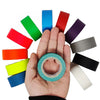
Gaffer Tape: The Essential Tool for Film Sets
, 5 min reading time

, 5 min reading time
Gaffer tape is an indispensable tool in the world of filmmaking and is a staple on every film set. Not just ‘another roll of tape’, it is an essential item for solving a wide range of on-set challenges. In this blog, we’ll explore what gaffer tape is, why it’s so valuable, and how it’s used to keep up with on set demands
Gaffer tape is an indispensable tool in the world of filmmaking and is a staple on every film set. Not just ‘another roll of tape’, it is an essential item for solving a wide range of on-set challenges. In this blog, we’ll explore what gaffer tape is, why it’s so valuable, and how it’s used to keep up with on set demands
Gaffer tape is a heavy-duty, cloth-backed adhesive tape with a matte finish. Its defining characteristics include:
These properties make gaffer tape perfect for the dynamic, fast-paced nature of film production.

Pictured: Fluorescent 1in Gaffter Tape
On a film set, gaffer tape is a jack-of-all-trades, used across various departments to tackle countless tasks. Here are some of the most common applications:
One of the primary uses of gaffer tape is to secure cables to floors, walls, or other surfaces. This ensures a safe working environment by reducing the risk of tripping hazards and keeping the set organised.
Example: Taping down audio, power, and lighting cables along the floor to prevent accidents and maintain a clean workspace.
Gaffer tape is often used to mark positions for actors, cameras, or equipment. Its clean removal ensures no damage to delicate surfaces.
Example: Placing markers on the floor to guide actors to their starting positions for each scene.
Gaffer tape’s heat resistance makes it ideal for use with lighting equipment. It can hold gels, diffusers, or barn doors in place without melting or leaving residue.
Example: Attaching coloured gels or diffusion material to lights to achieve the desired lighting effect.
Gaffer tape is often used for quick fixes on set, such as repairing props, costumes, or set pieces.
Example: Patching up a tear in a backdrop or temporarily mending a piece of set furniture.
When filming sound-sensitive scenes, gaffer tape can be used to muffle noises from equipment or secure loose parts that might rattle.
Example: Wrapping gaffer tape around a boom pole to prevent creaking or squeaks during operation.
Gaffer tape can double as a labeling tool. Its writable surface allows crew members to create custom labels for gear, cases, or cables.
Example: Marking camera batteries with tape to indicate charge levels.
Gaffer tape is often used to stabilise props or temporarily attach set decorations during shoots.
Example: Holding a picture frame in place on a wall that isn’t permanently mounted.
The wardrobe department uses gaffer tape for last-minute adjustments or fixes to costumes.
Example: Securing loose hems or attaching microphones discreetly to costumes.

Pictured: Coloured gaffer tape rolls showing 1in and 2in sizes.
Film production is fast-paced and unpredictable. Gaffer tape’s reliability and versatility make it an essential part of any toolkit. Its ability to adapt to countless situations ensures that crew members can handle emergencies and keep the production running smoothly.
From securing cables to making on-the-fly repairs, gaffer tape is the unsung hero of film production. Its features make it a versatile, reliable, and essential tool for any crew member. Whether you’re a gaffer, grip, or production assistant, having a roll of gaffer tape within arm’s reach can save the day more often than you might expect. The next time you’re on set, take a moment to appreciate the role this unassuming piece of kit plays in ensuring smooth operations on your production.